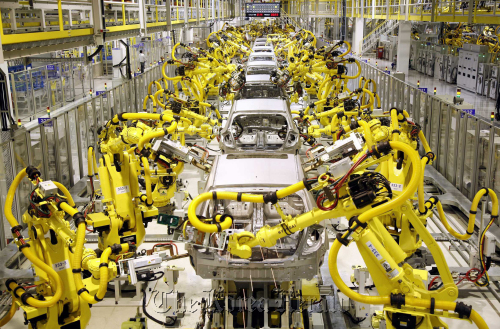Hyundai Heavy Industries set sights Thursday on the top three spots in the booming global robot market with its new plant ready to enter full-swing production.
The world’s top shipbuilder said it has remodeled and expanded existing production lines three times at its headquarter in Ulsan, a major industrial port city on the southeast coast of Korea, which began in September to meet surging demand for industrial robots.
With the new facilities, Hyundai said it more than doubled its annual production capacity to 4,000 robots from the previous 1,800, and plans to gradually raise it to 5,000. The robots are mainly designed to assemble automobiles and carry liquid crystal displays.
The world’s top shipbuilder said it has remodeled and expanded existing production lines three times at its headquarter in Ulsan, a major industrial port city on the southeast coast of Korea, which began in September to meet surging demand for industrial robots.
With the new facilities, Hyundai said it more than doubled its annual production capacity to 4,000 robots from the previous 1,800, and plans to gradually raise it to 5,000. The robots are mainly designed to assemble automobiles and carry liquid crystal displays.

“Hyundai Heavy has raised itself to a global robot maker through constant technology development since it entered the robot business in 1984,” said Kwon Oh-shin, chief of the company’s engine and machinery unit.
“We will penetrate into the top three spots in 2014 based on the increased production capacity.”
The sole Korean developer of industrial robots, Hyundai Heavy has been intensifying its robot production as a future growth engine.
Its stake in the industrial robot market reached 40 percent in Korea and 9 percent worldwide, the company said. It produced 3,000 robots last year, more than double compared with a year earlier.
In March, Hyundai and local venture firms have succeeded in localizing high-tech robotic equipment for artificial joint operations.
The firm plans to make main frames of the artificial surgeon on a mass scale in the first half at the earliest, and integrate controllers into the production line in 2013.
It targets a 60 percent stake in the global market for artificial joint surgical robots in 2015 by accumulating 200 billion won ($185.1 million) in sales.
The shipbuilder currently exports about 20 different kinds of car assembly robots and 10 types of robot LCD conveyors to Europe, China, India, Brazil and other countries, it said.
Despite slight declines during a recent global slump, robots have gained attention for their various applications and convenience amid a fast-aging population and looming labor shortage.
Korea trails Japan, Germany and the U.S. in the global robot industry, which is estimated at $9.4 billion in 2008 and is expected to grow to $100 billion in 2018, according to the Frankfurt-based International Federation of Robotics.
The mainstay of the high value-added industry is leaning to service robots that help with household and office chores and other various professional tasks including surgery, navigation, milking, teaching, demining and military patrol operations.
The government has been boosting investment and supporting research and development in the nascent sector as one of the 10 next-generation growth engines.
In December, the Ministry of Knowledge Economy introduced a comprehensive package to fund 30 billion won for the commercialization, standardization and marketing for service robots through 2017.
By Shin Hyon-hee (heeshin@heraldcorp.com)







![[KH Explains] How should Korea adjust its trade defenses against Chinese EVs?](http://res.heraldm.com/phpwas/restmb_idxmake.php?idx=644&simg=/content/image/2024/04/15/20240415050562_0.jpg&u=20240415144419)










![[Today’s K-pop] Stray Kids to return soon: report](http://res.heraldm.com/phpwas/restmb_idxmake.php?idx=642&simg=/content/image/2024/04/16/20240416050713_0.jpg&u=)